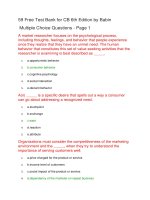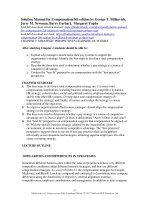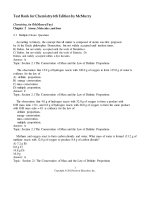Solution manual for statistics for managers 6th edition by levine
Bạn đang xem bản rút gọn của tài liệu. Xem và tải ngay bản đầy đủ của tài liệu tại đây (27.03 KB, 1 trang )
buy this full document at
CHAPTER 1
1.1
A population contains all the items of interest whereas a sample contains only a portion of
the items in the population.
1.2
A statistic is a summary measure describing a sample whereas a parameter is a summary
measure describing an entire population.
1.3
Descriptive statistical methods deal with the collection, presentation, summarization, and
analysis of data whereas inferential statistical methods deal with decisions arising from the
projection of sample information to the characteristics of a population.
1.4
An operational definition is a universally accepted meaning that is clear to all associated
with an analysis. Without an operational definition, confusion can occur.
1.5
Microsoft Excel could be used to perform various statistical computations that were possible
only with a slide-rule or hand-held calculator in the old days.
1.6
(a)
(b)
(c)
(d)
The population of interest was all the fulltime first-year students at the Midwestern
United States when the survey was conducted.
The sample that was collected consisted of those 2821 students who responded to the
survey.
An example of a parameter of interest could be the proportion in the population of all
the fulltime first-year students at this Midwestern United States who had studied
with other students.
The statistic that could be used to estimate the parameter in (c) was the 90.1% of
students in the sample who indicated that they had studied with other students.
1.7
The answers to this question depend on the article selected.
1.8
(a)
(b)
(c)
1.9
(a)
(b)
The population of interest was all adults living in the United States, aged 18 and
older when the survey was conducted.
The sample that was collected consisted of the 1,012 adults living in the United
States, aged 18 and older who were interviewed on the telephone during March 58, 2009.
The 80% is a statistic. It measured the proportion in the sample of 1,012 adults
living in the United States, aged 18 and older interviewed on the telephone during
March 5-8, 2009 who favored higher fuel efficiency standards for automobiles.
The population of interest was the collection of all 2100 business students at Northern
Kentucky University when the study was conducted.
The sample consisted of the 96 students that were involved in the study.
buy this full document at









